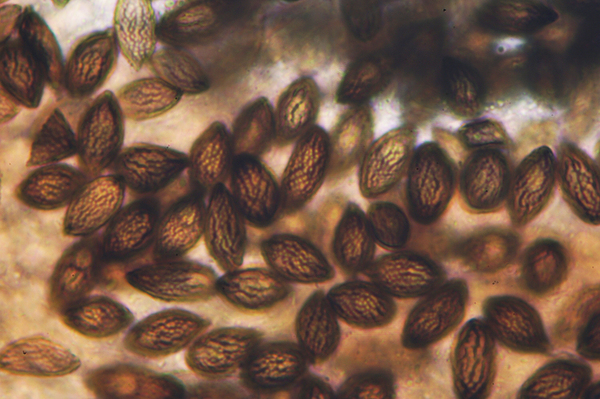Sphinctrina tubaeformis A. Massal.
Mem. Lichenogr.: 155, 1853.
Synonyms: Sphinctrina microcephala Nyl. non (Sm.) Körb.; Sphinctrina obducta Nyl.
Distribution: N - Frl (Puntillo & Puntillo 2009, Brackel 2016), Ven (Puntillo & Puntillo 2009, Lazzarin 2000b, Brackel 2016), TAA (Nascimbene & al. 2007b, Brackel 2016), Lomb (Puntillo & Puntillo 2009, Brackel 2016), Piem (Puntillo & Puntillo 2009, Brackel 2016), VA (Watson 2014), Lig (Puntillo & Puntillo 2009, Brackel 2016). C - Tosc (Puntillo & Puntillo 2009, Brackel 2016), Laz (Puntillo & Puntillo 2009, Brackel 2016), Sar (Puntillo & Puntillo 2009, Rizzi & al. 2011, Brackel 2016, Di Nuzzo & al. 2022). S - Camp (Ricciardi & al. 2000, Puntillo & Puntillo 2009, Brackel 2016, 2021), Pugl (Puntillo & Puntillo 2009, Brackel 2011), Cal (Puntillo 1994, 1996, Puntillo & Puntillo 2009, Brackel & Puntillo 2016, Brackel 2016).
Description: Thallus not evident, not lichenized. Apothecia short-stalked, 0.15-0.36 mm high, or rarely subsessile. Stalk black or dark brown, of periclinally arranged hyphae, pale in inner part, dark brown to reddish in outermost part (section). Capitulum subglobose to obovoid, 0.14-0.26 mm across. Exciple well-developed, of brown, more or less periclinally arranged hyphae; mazaedium well-developed, black. Asci 8-spored, cylindrical, formed singly from ascogenous hyphae with croziers, with a single, functional wall layer, K/I-, disintegrating at a rather late stage, with uniseriately arranged spores. Ascospores 1-celled, subfusiform, with pointed ends, dark brown, 10-15.5 x 6.5-9 µm, with an ornamentation of longitudinal coarse ridges. Photobiont absent. Spot tests: K-, C-, KC-, P-. Chemistry: without lichen substances.Note: a parasite on the thalli of crustose lichens, mostly Pertusaria leioplaca. Widespread throughout the country, but not common.
Growth form: Lichenicolous fungus
Substrata: bark
Reproductive strategy: mainly sexual
Most common in areas with a humid-warm climate (e.g. most of Tyrrenian Italy)
paras Pertusaria spp.
Commonnes-rarity: (info)
Alpine belt: absent
Subalpine belt: absent
Oromediterranean belt: absent
Montane belt: rare
Submediterranean belt: very rare
Padanian area: absent
Humid submediterranean belt: very rare
Humid mediterranean belt: absent
Dry mediterranean belt: absent

Predictive model
Herbarium samples


P.L. Nimis; Owner: Department of Life Sciences, University of Trieste
Herbarium: TSB (6334)
2003/03/17
on the thallus of the host, Pertusaria sp.

Marta González García and Enrique Rubio - Centro de Estudios Micológicos Asturianos
Spain, on Pertusaria

Marta González García and Enrique Rubio - Centro de Estudios Micológicos Asturianos
Spain, on Pertusaria

Marta González García and Enrique Rubio - Centro de Estudios Micológicos Asturianos
Spain, on Pertusaria

Marta González García and Enrique Rubio - Centro de Estudios Micológicos Asturianos
Spain, on Pertusaria

Marta González García and Enrique Rubio - Centro de Estudios Micológicos Asturianos
Spain, on Pertusaria

Marta González García and Enrique Rubio - Centro de Estudios Micológicos Asturianos
Spain, on Pertusaria

Marta González García and Enrique Rubio - Centro de Estudios Micológicos Asturianos
Spain, on Pertusaria
Growth form: Lichenicolous fungus
Substrata: bark
Reproductive strategy: mainly sexual
Most common in areas with a humid-warm climate (e.g. most of Tyrrenian Italy)
paras Pertusaria spp.
Commonnes-rarity: (info)
Alpine belt: absent
Subalpine belt: absent
Oromediterranean belt: absent
Montane belt: rare
Submediterranean belt: very rare
Padanian area: absent
Humid submediterranean belt: very rare
Humid mediterranean belt: absent
Dry mediterranean belt: absent

Predictive model
| Herbarium samples |


P.L. Nimis; Owner: Department of Life Sciences, University of Trieste
Herbarium: TSB (6334)
2003/03/17
on the thallus of the host, Pertusaria sp.

Marta González García and Enrique Rubio - Centro de Estudios Micológicos Asturianos
Spain, on Pertusaria

Marta González García and Enrique Rubio - Centro de Estudios Micológicos Asturianos
Spain, on Pertusaria

Marta González García and Enrique Rubio - Centro de Estudios Micológicos Asturianos
Spain, on Pertusaria

Marta González García and Enrique Rubio - Centro de Estudios Micológicos Asturianos
Spain, on Pertusaria

Marta González García and Enrique Rubio - Centro de Estudios Micológicos Asturianos
Spain, on Pertusaria

Marta González García and Enrique Rubio - Centro de Estudios Micológicos Asturianos
Spain, on Pertusaria

 Index Fungorum
Index Fungorum
 GBIF
GBIF




